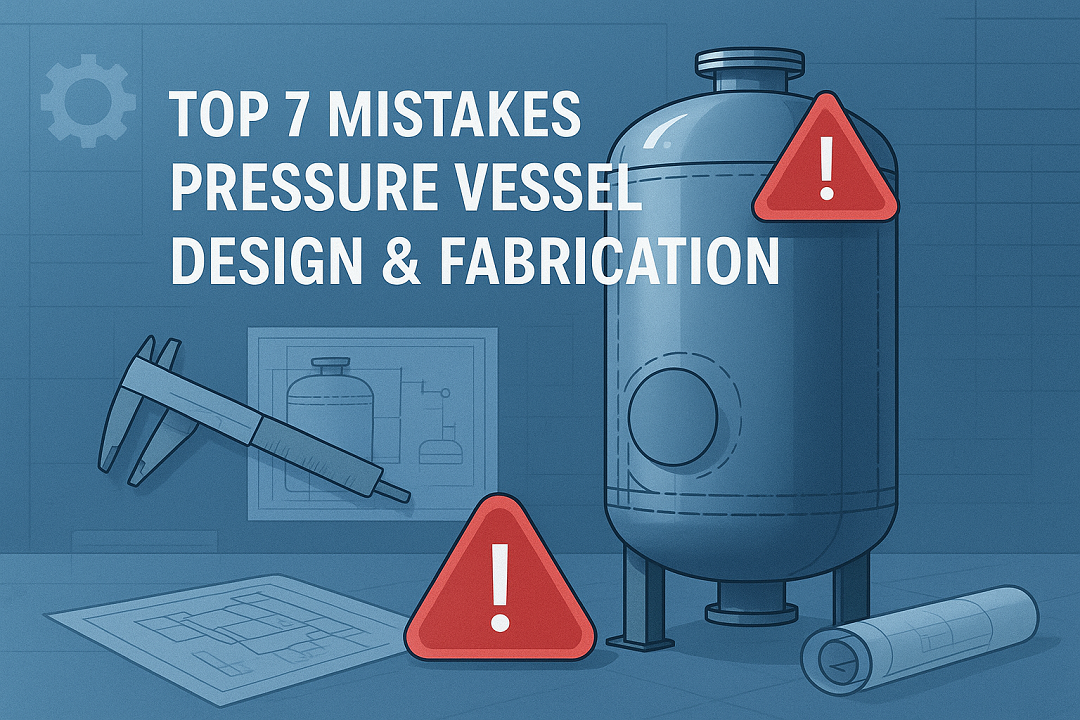
Top 7 Mistakes in Pressure Vessel Design & Fabrication
Pressure vessels are used in many industries. Oil and gas, chemicals, pharma, power plants… you name it. They work under high pressure. And sometimes in tough conditions. Even small mistakes in design or making them can cause big problems.
If you are in India and need ASME pressure vessels engineering services, it’s good to know the common mistakes. This can save time, money, and trouble. Here are the seven most common mistakes in ASME pressure vessel fabrication and design. And how to avoid them.
1. Neglecting ASME Code Compliance
- The ASME Boiler and Pressure Vessel Code is like the “rulebook” for making safe pressure vessels. Ignoring it, or following it half-way, can be risky. Everything matters—from choosing materials to welding.
- Companies in India should work with certified experts. This makes sure your vessels follow the code. And you avoid expensive mistakes later.
2. Inadequate Material Selection
- If you choose the wrong materials for pressure vessels. That can fail earlier than expected. Because of Corrosion, fatigue, and thermal stress.
- The selection of material must match the vessel’s conditions. And for that you have to consider Pressure, temperature, and the type of fluid.
- You can consider good Carbon steel in many cases. But often better options are corrosive settings, stainless steel or other alloys.
3. Improper Welding Techniques
- Welding is a key role for building pressure vessels. If welding is not properly done as have defects like cracks, porosity or weak fusion may appear. The vessel’s strength reduce by these flaws. The important things are skilled welders, the right filler materials, and careful inspections to maintain weld quality.
4. Failure to Conduct Adequate Testing
- Testing is important to confirm pressure vessels’ strength and safety. The typical methods are hydrostatic testing, radiographic inspection, and ultrasonic testing. If these tests are not done properly or skipped. These things can increase the chance of failure during operations.
5. Ignoring Fatigue Analysis
- Pressure vessels face repeated loading and over the time this can cause fatigue failure. If you ignored the fatigue analysis in the design stage then unexpected failures may occur. For vessels’ long-term use, designers must consider fatigue limits, stress points, and operating cycles.
6. Lack of Proper Documentation
- The detailed records are needed for pressure vessels. Details of records are material certificates, design data, welding steps and inspection reports. These are important for future tracking. If you have not done proper documentation. You face problems with maintenance and audits. In some cases, it brings heavy costs or the trouble of compliance
7. Overlooking Maintenance and Inspection Protocols
- Routine maintenance and care are needed for safe operation. Even with a perfect design, pressure vessels. If you neglect the required protocols, that can lead to undetected wear, corrosion, or many other issues, which may compromise the vessels’ integrity. A good maintenance routine keeps the vessels safe and sustainable for the long term.
Conclusion
Avoid these common mistakes in ASME pressure vessel fabrication and design. You needed them to keep vessels safe and vessels long-term use. Also, they help to meet industry compliance. Always follow ASME codes in ASME pressure vessels engineering services. Pick the right materials for the job.
Welding must be done by skilled hands. Poor welding can really weaken the vessel. You needed to do testing for the things that you cannot see at first glance. For testing, people commonly use things like hydro tests, X-rays, or even ultrasonic scans. On top of that, you have to check fatigue, too. Vessels face stress and cycles again and again over time. Keeping records of design and inspections is also needed. Documentation can make life way easier in the future during repairs and audits.
Additionally, a bit of regular care and simple maintenance also helps a lot. If you skip these, risks pile up and the vessel just won’t perform the same.
Here in India, many industries keep looking for skilled ASME experts. Work with people who know the job. It makes everything easier. It also ensures safe and strong pressure vessels.
FAQs
Q1. Why is ASME code compliance important in pressure vessel design?
ASME codes ensure safety, reliability, and compliance. Ignoring them can lead to design flaws, safety risks, and costly failures.
Q2. What happens if the wrong material is used in pressure vessel fabrication?
Using unsuitable materials can cause corrosion, fatigue, or early failure. Materials must match operating pressure, temperature, and fluid type.
Q3. How do welding defects affect pressure vessels?
Poor welding may lead to cracks, porosity, or weak joints, reducing vessel strength. Skilled welders and proper inspections are essential.
Q4. Why is fatigue analysis critical for pressure vessels?
Vessels face repeated loading cycles. Without fatigue analysis, they may fail unexpectedly during long-term operations.
Q5. What role does maintenance play in pressure vessel safety?
Regular inspections and maintenance detect wear, corrosion, and stress damage early, ensuring long-term safety and compliance.

Krupal Patel
Krupal Patel is the CEO of Neocent Engineering Pvt. Ltd., Ahmedabad, specializing in advanced engineering solutions. With over 8 years of expertise in Product Design, FEA, CFD, and ASME-BPVC stress analysis, he has successfully delivered high-precision projects across pressure vessels, piping, and structural systems.
